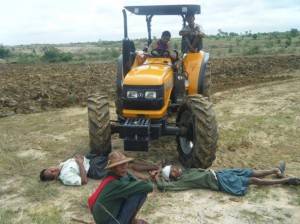Burma’s Military and Economic Elites Continue to Steal the Livelihoods of Rural People
By Burma Partnership • July 30, 2012 As more and more farmers are losing their lands and livelihoods to corrupt businesses long-associated with the Burma Army, the current government is doing its best to preserve the interests of these wealthy elites at the expense of disempowered rural people. With the onset of the gold rush into Burma, these cronies of the military-backed government are abusing their position to reap the financial rewards of the potential flood of new investment while rural people, who make up 90% of the population, are losing their livelihoods.
As more and more farmers are losing their lands and livelihoods to corrupt businesses long-associated with the Burma Army, the current government is doing its best to preserve the interests of these wealthy elites at the expense of disempowered rural people. With the onset of the gold rush into Burma, these cronies of the military-backed government are abusing their position to reap the financial rewards of the potential flood of new investment while rural people, who make up 90% of the population, are losing their livelihoods.
One such example is from Bwi Daw Village in Kachin State where residents reported last week of local businessmen confiscating their land at gunpoint and subsequently destroying their crops with tractors to make room for a fish farm. For these villagers, there is no legal remedy and have now lost the ability to put food on the table for their families.
Protests, however, are becoming more and more common as land grabbing is becoming the most prevalent problem for people from all communities across the country. Last Wednesday in Meikhtila District of Mandalay Division, three farmers lay in front of a tractor to protest the confiscation of their land by Kaungkin (Sky) Company without any compensation being paid out. Mango and thanaka trees have already been planted on their land. Such desperate and brave actions are undertaken as they have no other choice. As, Htay Htay Myint, a farmer whose land was taken by Kaungkin points out, “We do not know how to do anything but farm work. Since we lost our land, which was inherited from our grandparents, how can we survive? We would like to request the president to help us.”
The President, however, adheres to the 2008 military-authored Constitution. Article 37 of which forms the basis of the law on land confiscations, states that, “The Union is the ultimate owner of all lands and all natural resources above and below the ground, above and beneath the water and in the atmosphere in the Union.” Furthermore, Section 29 allows the state to take over any land in “the national interest.” This is compounded by the 2012 Farmland Bill that, among many other flaws, reinforces the concept that all land is owned by the state while all decisions regarding usage of this land is to be decided by a Farmland Management Body composed of government appointees.
This is particularly problematic when looking at some of the current disputes between companies and farmers, as those who have a vested interest in the land they are confiscating can also be MPs. The Zay Kabar Company launched a defamation lawsuit against the Peace and Diversity Party Chairman, Nay Myo Wai after he helped farmers organize a protest against their land grabbing. The owner of Zay Kabar is Khin Swe, an MP for the military-backed Union Solidarity and Development Party (USDP). The absurdity of this situation only serves to further disenfranchise those who have been working on these lands for generations.
Lawsuits and threats of prosecution are becoming a favorite method that the government uses to intimidate farmers. On 18 July, Pegu Division’s Security and Border Affairs Minister, Thet Htun threatened to sue farmers who are continuing to plough land that has recently been confiscated by the Burma Army.
The government is keen to present itself as working towards the benefit of farmers and their land rights, and announced in Parliament this week that a committee will be formed to investigate such cases. Yet if members of the government themselves or their close associates are committing the abuses, how will this committee bring any justice for the victims?
For this problem to be solved, there needs to be a strong legal framework in place that protects people’s rights to their land from the military elites and their cronies who are abusing their power for financial gain as Burma opens up to more foreign investment. Disputes must be solved by an independent judiciary, not by government members who are confiscating the land themselves.
Tags: Burma Partnership, Farmers, Land Confiscation, ProtestThis post is in: Blog
Related PostsBurma Partnership Celebrates Continuing Regional Solidarity for Burma and Embraces the Work Ahead for Progressive Voice
Burma Army Displays Blatant Disregard for 21st Century Panglong Peace Process
Ann Din Coal Power Plant: Local Movement and Action to Preserve and Protect Natural Resources and Land: Mon IDP Report Case Study #4
Latest Human Rights Abuse Case Demonstrates Urgent Need to Reform the Myanmar National Human Rights Commission
Human Rights Far From Guaranteed as US Sanctions on Burma Are Removed









 All posts
All posts